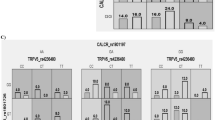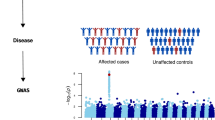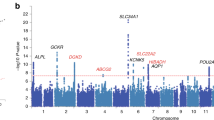Abstract
Background
Genetic factors play a key role in the pathogenesis of hypocitraturia, a common risk factor for nephrolithiasis. The Na+-dicarboxylate cotransporter NaDC1, encoded by the sodium-dicarboxylate cotransporter (SLC13A2) gene, is a major determinant of urinary citrate excretion and its biological functions are regulated also by the vitamin D/Vitamin D receptor (VDR) biological system. The aim of this case-control study was to evaluate the possible epistatic interaction between VDR rs731236and SLC13A2 rs11567842 allelic variants in the pathogenesis of hypocitraturia.
Methods
Recurrent calcium-oxalate stone formers (SF) with or without hypocitraturia and healthy controls (C) were genotyped. Gene–gene interactions were estimated by the 1.0 software package of multifactor dimensionality reduction (MDR).
Results
The prevalence of VDR TT and SLC13A2 GG genotypes was higher in hypocitraturic SF compared to C (odds ratio [OR] 3.24, 95 % confidence interval [CI] 1.38–7.60 for VDR TT vs. VDR tt and OR 4.06, 95 % CI 1.75–9.42 for SLC13A2 GG vs. SLC13A2 AA). MDR analysis indicated a significant interaction between VDR TT and SLC13A2 GG in hypocitraturic SF compared to C [OR 3.81 (2.11–6.88)]. These data are compatible with an epistatic interaction between the VDR TT and SLC13A2 GG genotypes with a significant impact on the magnitude of the effect (suppressive effect).
Conclusions
These results point to an epistatic interaction between the VDR and the SLC13A2 alleles in the pathogenesis of idiopathic hypocitraturia in calcium-oxalate SF.

Similar content being viewed by others
References
Romero V, Akpinar H, Assimos DG (2010) Kidney stones: a global picture of prevalence, incidence, and associated risk factors. Rev Urol 12:e86–e96
Civelek M, Lusis AJ (2014) Systems genetics approaches to understand complex traits. Nat Rev Genet 15:34–48. doi:10.1038/nrg3575
Halbritter J, Baum M, Hynes AM et al (2015) Fourteen monogenic genes account for 15 % of nephrolithiasis/nephrocalcinosis. J Am Soc Nephrol 26:543–551. doi:10.1681/ASN.2014040388
Lieske JC, Turner ST, Edeh SN et al (2014) Heritability of urinary traits that contribute to nephrolithiasis. Clin J Am Soc Nephrol 9:943–950. doi:10.2215/CJN.08210813
Wei WH, Hermani G, Haley CS (2014) Detecting epistasis in human complex traits. Nat Rev Genet 15:722–733. doi:10.1038/nrg3747
Worcester EM, Coe FL (2010) Clinical practice. Calcium kidney stones. N Engl J Med 363:954–963. doi:10.1056/NEJMcp1001011
Zuckerman JM, Assimos DG (2009) Hypocitraturia: pathophysiology and medical management. Rev Urol 11:134–144
Zacchia M, Preisig P (2010) Low urinary citrate: an overview. J Nephrol 23(Suppl 16):S49–S56
Mossetti G, Vuotto P, Rendina D et al (2003) Association between vitamin D receptor gene polymorphisms and tubular citrate handling in calcium nephrolithiasis. J Intern Med 253:194–200
Okamoto N, Aruga S, Matsuzaki S et al (2007) Associations between renal sodium-citrate cotransporter (hNaDC-1) gene polymorphism and urinary citrate excretion in recurrent renal calcium stone formers and normal controls. Int J Urol 14:344–349
Zhu C, Ye Z, Chen Z et al (2010) Association between vitamin D receptor gene polymorphisms and idiopathic hypocitraturia in the Chinese population. Urol Int 85:100–105
Pajor AM (1996) Molecular cloning and functional expression of sodium-dicarboxylate cotransporter from human kidney. Am J Physiol 270:F642-648.
Haussler MR, Jurutka PW, Mizwicki M et al (2011) Vitamin D receptor (VDR)-mediated actions of 1α,25(OH) 2 vitamin D 3: genomic and non-genomic mechanisms. Best Pract Res Clin Endocrinol Metab 25:543–559
Hamm LL, Hering-Smith KS (2002) Pathophysiology of hypocitraturic nephrolithiasis. Endocrinol Metab Clin North Am 31:885–893
Pajor AM, Sun N (1999) Protein kinase C-mediated regulation of the renal Na(+)/dicarboxylate cotransporter, NaDC-1. Biochim Biophys Acta 1420:223–230
Eastell R, Brandi ML, Costa AG et al (2014) Diagnosis of asymptomatic primary hyperparathyroidism: proceedings of the fourth international workshop. J Clin Endocrinol Metab 99:3570–3579. doi:10.1210/jc.2014-1414
Lindberg JS, Sprague SM (2001) Nephrolithiasis. In: DeGroot LJ, Jameson JL (eds) Endocrinology. W.B. Saunders Company, Philadelphia, pp 1169–1180
Levy FL, Adams-Huet B, Pak CY (1995) Ambulatory evaluation of nephrolithiasis: an update of a 1980 protocol. Am J Med 98:50–59
Smulders MY, Frissen PHJ, Slaats EH et al (1996) Renal tubular acidosis. Pathophysiology and diagnosis. Arch Intern Med 156:1629–1636
Rudman D, Dedonis JL, Fountain MT et al (1980) Hypocitraturia in patients with gastrointestinal malabsorption. N Engl J Med 303:657–661
Pak CY, Poindexter JR, Adams-Huet B et al (2003) Predictive value of kidney stone composition in the detection of metabolic abnormalities. Am J Med 115:26–32
Hahn LW, Ritchie MD, Moore JH (2003) Multifactor dimensionality reduction software for detecting gene-gene and gene-environment interactions. Bioinformatics 19:376–382
Goldfarb DS, Fischer ME, Keich Y et al (2005) A twin study of genetic and dietary influences on nephrolithiasis: a report from the Vietnam Era Twin (VET) Registry. Kidney Int 67:1053–1061
Arcidiacono T, Mingione A, Macrina L et al (2014) Idiopathic calcium nephrolithiasis: a review of pathogenic mechanisms in the light of genetic studies. Am J Nephrol 40:499–506. doi:10.1159/000369833
Vezzoli G, Terranegra A, Arcidiacono T et al (2011) Genetics and calcium nephrolithiasis. Kidney Int 80:587–593. doi:10.1038/ki.2010.430
Lee Hamm L (1990) Renal handling of citrate. Kidney Int 38:728–735
Pajor AM, Sun N (2010) Single nucleotide polymorphisms in the human Na+-dicarboxylate cotransporter affect transport activity and protein expression. Am J Physiol Renal Physiol 299:F704–F711. doi:10.1152/ajprenal.00213.2010
Uitterlinden AG, Fang Y, Van Meurs JB et al (2004) Genetics and biology of vitamin D receptor polymorphisms. Gene 338:143–156
Barsony J, Renyi I, McKoy W (1997) Subcellular distribution of normal and mutant vitamin D receptors in living cells. J Biol Chem 272:5774–5782
Cordell HJ (2002) Epistasis: what it means, what it doesn’t mean, and statistical methods to detect it in humans. Hum Mol Genet 11:2463–2468
Burga A, Lehner B (2013) Predicting phenotypic variation from genotypes, phenotypes and a combination of the two. Curr Opin Biotechnol 24:803–809. doi:10.1016/j.copbio.2013.03.004
Mackay TF (2014) Epistasis and quantitative traits: using model organisms to study gene–gene interactions. Nat Rev Genet 15:22–33. doi:10.1038/nrg3627
Fisher RA (1918) The correlation between relatives on the supposition of Mendelian inheritance. Trans R Soc Edin 52:399–433
Li K, Mo Y, Shen J et al (2016) Expression of VDR and NaDC1 in HK-2 cells and their significance in hypocitraturia. Kunming yi ke da xue xue bao 37:35–39
Liu Y, Saccucci P, Qi H et al (2006) ADA polymorphisms and asthma: a study in the Chinese Han population. J Asthma 43:203–206
Author information
Authors and Affiliations
Corresponding author
Ethics declarations
Conflict of interest
On behalf of all authors, the corresponding author states that there is no conflict of interest.
Ethical approval
All procedures performed in studies involving human participants were in accordance with the ethical standards of the institutional and/or national research committee and with the 1964 Helsinki declaration and its later amendments or comparable ethical standards.
Informed consent
Informed consent was obtained from all individual participants included in the study.
Rights and permissions
About this article
Cite this article
Rendina, D., De Filippo, G., Gianfrancesco, F. et al. Evidence for epistatic interaction between VDR and SLC13A2 genes in the pathogenesis of hypocitraturia in recurrent calcium oxalate stone formers. J Nephrol 30, 411–418 (2017). https://doi.org/10.1007/s40620-016-0348-8
Received:
Accepted:
Published:
Issue Date:
DOI: https://doi.org/10.1007/s40620-016-0348-8




